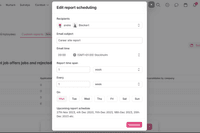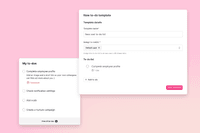New: Measure your candidate experience with NPS


Suzan Dil
Get to know what your candidates think of your recruitment process and get valuable feedback. Take control over your employer brand and get the data to improve it.
What is NPS?
NPS stands for Net Promoter Score. It is often used by companies to measure their satisfaction among their customers or employees. It consists of an email survey with the question "How likely is it that you would recommend our company/product/service to a friend or colleague?"
The main goal with an NPS is to get to know the recipient's satisfaction, and to be able to respond to their feedback, to make sure you do everything to make or keep them satisfied.
Why should we use it for our recruitment?
Improve your employer brand
Get the data to learn and improve your work by using the feedback directly from your candidates. No other feedback can be as accurate as theirs and by using this for your processes, you will make sure that you make it even better. No matter what kind of response you get – by replying to it and taking action, you will improve your work and employer brand.
Candidate today, customer tomorrow
People speaking about your brand in a negative way will surely affect your company. They are likely to not only share their negative experiences with their inner circle, but also shout it to the world by posting on social media. This will affect the way your brand is perceived, and could potentially slow down your business.
Important KPI
Make your NPS a KPI at your company and show your colleagues what your candidates think of your processes. Your candidates are equally as important as your customers (if not more) and the rest of your company should know that.
Show them that they matter
Asking candidates about their impression of your recruiting process shows that you are eager to make them happy. Companies that make an effort will also be rewarded.
How does it work?
Go to the candidate profile and click the three dots in the top. Choose Send NPS survey. If your candidate has applied to several jobs, you will be able to choose which job you would like to associate with this particular answer.

When you've sent it, you will see Waiting for response on the candidate card, and when you sent the survey.

To automate this process, you can also add this as a Trigger. Go to a job's stages view, and click Add Trigger.

What does the survey look like?
Your candidates get an email with the subject "Help us get better". Your name and company name is the sender. Here's what the survey looks like:

If the candidate replies with a 9 or a 10, they will get some confetti on the thank you page, where they can also leave additional feedback.
Don't we all love confetti? 🎉

Analyze the responses
In Analytics, you will have two new reports. The NPS Overview shows an overview over all of your responses, and a graph that shows your score over time. In the NPS per stage, you will see the scores for each stage.

NPS per stage
This report shows in which stage the candidate was when they answered to your NPS. This is a great way to analyze the correlation between the different stages and the responses your candidates give you. Maybe you see that candidates that only reached the inbox stage has certain feedback? Or that candidates that have had a second interview notice something else?

NPS overview
Get a full overview of all your scores and feedback. This is the best place to work with your NPS and get back to your candidates. Act on the feedback and improve your results. Click Reply under the feedback to get back to the candidate right away.
You can also export this report to share with others.

What does the scores mean?
The recipient can answer the question "How likely are you to recommend a friend or colleague to apply for a job at {company_name}" with a number from 0 to 10. He/she is also given the option to give extra feedback.
Those who answers numbers between:
- 0-6 are Detractors
- 7-8 are Passive
- 9-10 are Promoters
The total Net Promoter Score is calculated by subtracting the percentage of candidates who are Detractors from the percentage of candidates who are Promoters. Passives are not counted for the total score, but does however increase the number of respondents, which means it decreases the percentage of detractors and promoters.
Read more about NPS and how the scores are calculated here.
Let us know what you think of this feature and if you need any help getting started! 🚀
Recommended topics
![]()
Highlights from our latest releases ✨✨
We've collected the highlights from our latest releases. Co-pilot, historic reports and more.
![]()
Set a Job Name that's only shown internally
Make collaboration easier by naming your job what it's called internally, and use a different job ad title for the candidates to see.
![]()
Automatically add to-dos for new users 🥳
Add custom to-do templates so that each new user knows exactly what to do as they first log in, depending on their access level.


